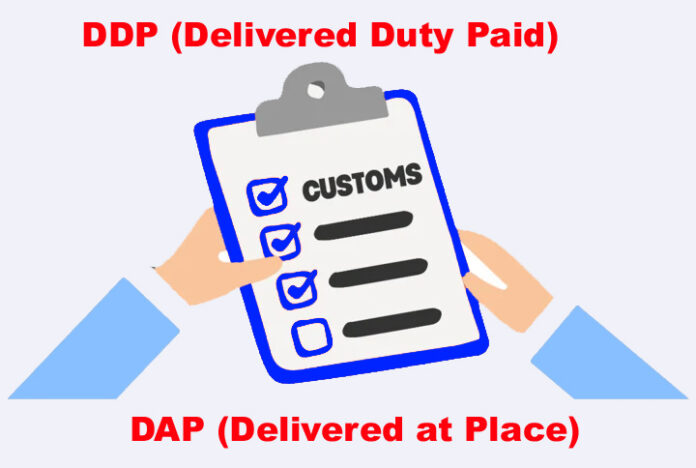DDP (Delivered Duty Paid) and DAP (Delivered at Place) are two popular Incoterms used in international trade to define the seller’s and buyer’s responsibilities regarding the delivery of goods. Here’s a detailed explanation of each:
1. DDP (Delivered Duty Paid)
Definition: Under DDP, the seller assumes full responsibility for delivering the goods to the buyer’s premises or a specified destination (usually in the buyer’s country). The seller takes on all costs and risks associated with shipping the goods, including import duties, taxes, and any customs clearance required for import.
Seller’s Responsibilities in DDP:
- Transport costs: The seller arranges and pays for the cost of transport to the destination, including shipping, handling, and any other logistics costs.
- Import duties and taxes: The seller is responsible for paying import duties, customs clearance, and any applicable taxes at the destination country.
- Insurance: The seller may also choose to arrange insurance for the shipment.
- Risk: The seller bears the risk of loss or damage to goods during transit, including customs procedures at the destination country.
Buyer’s Responsibilities in DDP:
- Delivery to destination: The buyer’s responsibility is simply to receive the goods at the agreed-upon destination.
- No additional costs: The buyer doesn’t have to arrange for shipping or pay import duties or taxes.
When to use DDP:
- Best for buyers who want a turnkey service, where everything is handled by the seller, and the buyer receives the goods at their location without having to deal with logistics or customs.
- Best for sellers who are familiar with the destination country’s customs regulations and are willing to take on more responsibility for ensuring a smooth delivery.
2. DAP (Delivered at Place)
Definition: Under DAP, the seller is responsible for delivering the goods to a specified place in the buyer’s country, usually near the buyer’s premises or another agreed location. However, unlike DDP, the buyer is responsible for paying any import duties and customs clearance upon arrival of the goods.
Seller’s Responsibilities in DAP:
- Transport costs: The seller arranges and pays for the cost of transporting goods to the specified destination.
- Risk: The seller assumes the risk of loss or damage until the goods are delivered to the agreed place.
- Insurance: The seller may choose to insure the shipment during transport.
- Customs clearance: The seller is not responsible for customs clearance in the destination country.
Buyer’s Responsibilities in DAP:
- Import duties and taxes: The buyer must handle the import customs clearance, including paying the import duties, taxes, and other fees related to bringing the goods into the country.
- Delivery: The buyer is responsible for unloading the goods and transporting them to their final destination, if necessary.
When to use DAP:
- Best for sellers who want to handle the delivery logistics to the destination but do not want to be responsible for customs clearance and import duties at the destination.
- Best for buyers who prefer to manage import duties and customs clearance themselves or have existing expertise in handling those aspects.
Key Differences Between DDP and DAP:
| Aspect | DDP (Delivered Duty Paid) | DAP (Delivered at Place) |
| Seller’s Responsibility | Seller covers all costs and risks (transport, duties, taxes, etc.). | Seller covers transport and risk until delivery. |
| Import Duties & Taxes | The seller always pays all import duties, taxes, and customs clearance. | The buyer always pays import duties and customs clearance. |
| Risk Transfer | Risk is transferred once goods are delivered to the buyer. | Risk is transferred once goods are delivered to the specified place. |
| Insurance | Sellers may provide insurance but it’s not mandatory. | Sellers may provide insurance but it’s not mandatory. |
| Buyer’s Responsibility | Buyer is only responsible for receiving the goods at the destination. | The buyer is always responsible for customs clearance and import duties. |
Summary of DDP vs. DAP
- DDP (Delivered Duty Paid): The seller takes full responsibility for all aspects of delivery, including customs duties and taxes, while the buyer only has to receive the goods.
- DAP (Delivered at Place): The seller is responsible for delivery and transport costs but the buyer takes responsibility for import duties and customs clearance.
Which Incoterm is Better for the Seller or Buyer?
- For Sellers:
- DDP may be more appealing if the seller wants to offer a complete service to the buyer and is capable of handling customs procedures and duties in the destination country.
- DAP could be a better option if the seller wants to limit their responsibility after delivering the goods to a specific location and does not want to deal with import duties or customs clearance.
- For Buyers:
- DDP is attractive if the buyer wants a turnkey solution, with minimal responsibility for logistics, customs, or duties.
- DAP is good if the buyer is familiar with customs clearance processes in their country and prefers to handle import duties and taxes themselves.
Conclusion:
- DDP is ideal for buyers who want the seller to handle everything and for sellers who are willing to manage the entire shipping and customs process.
DAP is a good option for sellers who want to manage the delivery up to a point but prefer to leave customs and duties responsibilities to the buyer.




